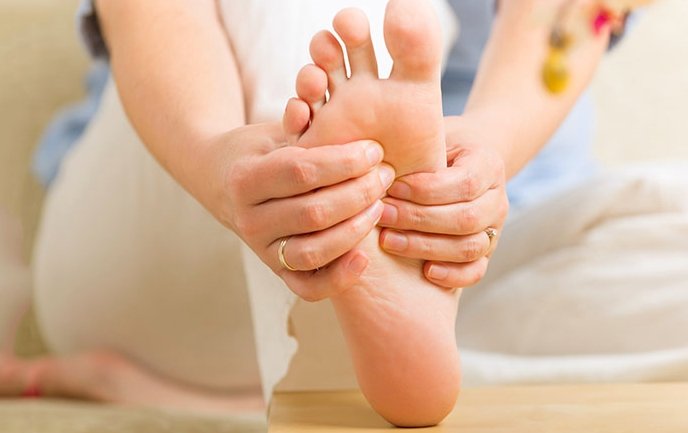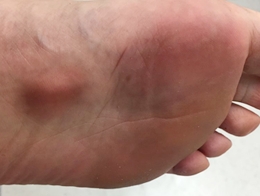Supination of the Foot
Supination of feet is a process of the natural gait cycle which involves a tri-planar motion causing the feet to move down and towards the centre of the body. Supination of feet involves a combination of inversion (twisting of the foot inward), plantarflexion (movement of your foot away from the body by bending your ankle) and adduction (movement of the foot towards the centre of the body). Excessive supination, also known as underpronation disturbs the overall body alignment, thereby making your gait unsteady.
What is supination of foot?
Have you tried to observe your feet while you are walking or running? You would notice that your feet tend to roll outwards as a process of normal motion. This rolling out of your feet between the uppermost bone of the foot that connects to the ankle (talus) and heel bone (calcaneus) is called as supination. A small amount of supination occurs naturally during your normal gait which allows your feet to form a rigid structure that helps in moving forward. However, excessive supination (over-supination) leads to poor shock absorption and may generate undue strain on the muscles and tendons around your ankles. This may cause your ankles to completely roll over, thereby causing sprain or ligament rupture in the ankle, shin splint and fracture of the heel bone.
How can I know whether I am over-supinating?
- Over-supination presents some common symptoms like arch pain, heel pain, flat foot, formation of corns and calluses on feet, ankle sprain and Achilles tendinitis. Severe cases of over-supination may lead to muscle tightness in the thigh and pain in knees, hip and back.
- You can identify over-supination just by observing the sole of your shoes. If the sole looks more worn out on the outer edges than rest of the parts, you may be over-supinating while walking or running.
- Observe the inside of your feet in the mirror. High arches on the inside of your feet may indicate over-supination.
- Take the wet foot test. Wet your feet thoroughly and take a walk along a smooth pavement; take a look at the footprints left by you.
- If your gait is normal, your will observe footprints in which the heel of your foot is connected to the forefoot by a strip which is approximately half the width of your foot on the outer sole.
- However, if you are over-supinating while walking, you will observe footprints in which your heel and forefoot are connected by a very thin strip on the outside, which may sometimes not even be visible.
- People with over-supination may be pigeon-toed or have feet that turn inward while walking or standing.
What are the causes of over-supination?
Over-supination occurs very rarely and is the least common foot type. Over-supination may be caused as a result of poor walking habits. This condition may also be attributed to genetic predisposition as in the case of high arches. Some people over-supinate since childhood. In some cases, prior injury to the feet may lead to over-supination.
Treatment
Choosing the right pair of shoes
Over-supination in most cases can be treated by just wearing the right pair of shoes that are well-cushioned. If you feel that you are suffering from over-supination, visit a podiatrist immediately to get a complete-foot strike and running gait analysis done. Based on the results of these tests, the podiatrist may be able to suggest appropriate shoes for you that will help in preventing further over-supination. While buying shoes, it is necessary to measure the length, width and depth of your feet to get a better fit and to alleviate the discomfort. Your feet tend to swell as the day progresses; therefore it is advisable to buy new pair of shoes in the later part of the day.
Orthotic inserts
If there is excessive supination that won’t go away even after wearing the right pair of shoes, you may use a pair of orthotic inserts, deep heel cups, heel wedges or insoles in your shoes. You may find a pre-molded orthotic insert that can be bought off the shelf. However, it is advisable to buy specially casted insoles or inserts that is customized for your feet.
Exercises
- Stretching and strengthening exercise may help to impart strength to the ankles that may have turned weak due to the repeated sprains or fractures.
- Athletes who suffer from over-supination should indulge in stretching exercises to lengthen the tendons and muscles in the feet. Hamstring or calf stretches may help in relieving the stiffness that occurs due to over-supination. It may also help you to improve your gait.
- You can strengthen your thigh muscles by stretching your quad and calf muscles. To perform quad stretching, stand still with your palms pressed firmly against a wall. Place one of your foot behind your buttocks and pull the leg up allowing your thigh muscles to stretch thoroughly. Hold on for 10-15 seconds, relax and repeat the same procedure on the other leg.
- To stretch your calf muscle, place your palms pressed against a wall and place one leg back, putting pressure on the forefoot. Bend the other knee and lean in to the bent knee. Hold on for 10-15 seconds and repeat the exercise on the other foot.
- Due to over-supination, you may sometimes experience pain in your inner thighs after walking or running for a longer period of time. You can strengthen the muscles in your inner thighs by raising your leg up and down while lying down sideways on the floor.
- If you suffer from heel pain, it may be due to a condition called plantar fasciitis, which may occur as sequelae to over-supination. Plantar fasciitis occurs due to swelling and irritation in the plantar fascia which is a flat band of ligament that connects your heel bone and toes and provides support to the arch of your foot. To ease the pain in your heels, you can perform stretching exercises for the plantar fascia by sitting on the floor with your legs outstretched and trying to hold one of your toes. Then pull your foot upward and hold it in this position for 10-15 seconds. Relax and repeat the same procedure on your other foot.
- Strengthening the muscles in front of your shin can help you to walk steadily. You may try simple exercises like jump roping or step-ups to improve the alignment of your feet and to train them to land properly.
- Always bear in mind that you should gradually increase the intensity of exercise. If you are wearing new shoes or orthotic inserts, start with a less strenuous version of exercise and slowly progress towards the more difficult form of work-outs, making sure that you do not experience any pain due to the exercise. It is advisable to consult a physiotherapist to know the exercise that suits you best.







